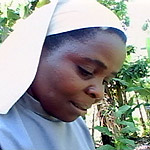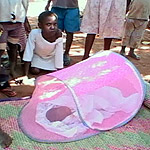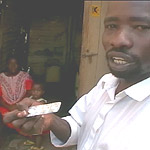|
Anti-microbial resistance -- germs becoming resistant to medicine -- is part of the natural history of infectious disease. No drug can kill every single harmful microbe. A few bugs inside a sick person always survive. Over time, these resistant microbes may come to predominate, rendering formerly effective medicines useless. In Uganda, as in other African countries, the fight against disease is a race against drug resistance. |
 |
| Sister Florence Nawanga grows artemesia near Entebbe |
Sister Florence Nawanga is an herbalist at a convent near Entebbe in south-central Uganda. For the last few years, she's been cultivating an herb that's native to China, but that might hold the key to defeating malaria in Africa, too. “This is the plant,” she says, pointing to a small fern-like plant she’s seeded in the bush near the convent.
It's called "sweet wormwood," or Artemesia annua, and the drug derived from it, artemisinin, is the key ingredient of what is currently the most effective anti-malarial medicine. It came into use just as older anti-malarials such as chloroquine and quinine began to fail.
 |
| Few Ugandans can afford insecticide-treated mosquito nets for their children |
Malaria caused by a mosquito-borne parasite, kills more than one million Africans each year, most of them young children. Almost everyone in Uganda has had it at one time or another, especially those who can't afford an insecticide-treated mosquito net, a category that includes most Ugandans.
In the Kampala slum of Katanga, a grandmother cares for 11 children without a single mosquito net, administering the older, less effective anti-malaria drugs to the baby. Last week, she says, the medicine failed to save the youngest child in her care.
 |
| Children in Kampala’s Katanga slum |
Malaria, AIDS/HIV, tuberculosis and poverty reinforce each other in Africa, making each more deadly. Doctors say that malarial fevers in an HIV-infected person are likely to bring on full-blown AIDS, and that most African AIDS patients actually succumb to tuberculosis. The AIDS virus, too, is becoming resistant to less costly, first-line anti-retroviral drugs. And doctors note that in all three illnesses, poor people are less likely to complete drug therapies, a major cause of drug resistance.
 |
| Dr. Martin Okot-Nwang, head of TB treatment at Kampala’s Mulago Hospital |
“Because the patient is interrupted in taking the drugs, the bug recovers,” says Dr. Martin Okot-Nwang, who is the head of tuberculosis treatment at Mulago Hospital in Kampala. “And when it recovers, it's definitely not going to be the same bug."
Dr. Okot-Nwang says perhaps the most important way to prevent an even deadlier variant -- multiple-drug-resistant, or MDR tuberculosis -- is using community-based volunteers to make sure that patients complete their drug regimen even after they feel better. “This means someone in the neighborhood who is trained locally to give the patient TB drugs,” he explains, “and who records on the TB cards as the patient swallows the drugs.”
 |
| A resident social worker in Katanga distributes anti-malarials |
Community-based workers are also being used to fight malaria. Richard is a social worker who distributes free anti-malaria drugs from Mulago Hospital to his fellow slumdwellers. He shows a reporter the green and red Homapaks, as they’re called: green ones for children from two years to five years, and red for babies aged two months to two years. The packs contain the first-line combination treatment of chloroquine and Fansidar (sulfadoxine and pyrimethamine): not as effective now as artemesinin, but far better than nothing.
Ugandan doctors say that increased funding from the rest of the world for combating HIV/AIDS, TB and malaria is making a real difference in Uganda. There is other good news: recently, researchers at the University of California at Berkeley announced they have grown a purer form of artemisinin in the laboratory, using yeast cells. This synthetic form could be the basis for a low-cost combination treatment, lifting the burden of malaria from African peoples and economies. But scientists also warn that if artemisinin is not used correctly as part of a drug-combination cocktail, the malaria parasite will quickly become resistant to it as well.

